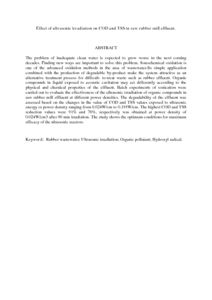Citation
Chua, Sze Ye and Abdul Latif, Puziah and Ibrahim, Shaharin and Rosli, Nurliza and Aziz, Sidek
(2010)
Effect of ultrasonic irradiation on COD and TSS in raw rubber mill effluent.
Environment Asia, 3 (spec.).
pp. 32-35.
ISSN 1906-1714
Abstract
The problem of inadequate clean water is expected to grow worse in the next coming decades. Finding new ways are
important to solve this problem. Sonochemical oxidation is one of the advanced oxidation methods in the area of wastewater.Its simple application combined with the production of degradable by-product make the system attractive as an alternative treatment process for difficult- to-treat waste such as rubber effluent. Organic compounds in liquid exposed to acoustic cavitation may act differently according to the physical and chemical properties of the effluent. Batch experiments of
sonication were carried out to evaluate the effectiveness of the ultrasonic irradiation of organic compounds in raw rubber mill effluent at different power densities. The degradability of the effluent was assessed based on the changes in the value of COD and TSS values exposed to ultrasonic energy or power density ranging from 0.024W/cm to 0.188W/cm. The highest COD and TSS reduction values were 91% and 76%, respectively was obtained at power density of 0.024W/cm3 after 90 min irradiation. The study shows the optimum conditions for maximum efficacy of the ultrasonic reactors.
Download File
![[img]](http://psasir.upm.edu.my/14323/1.hassmallThumbnailVersion/Effect%20of%20ultrasonic%20irradiation%20on%20COD%20and%20TSS%20in%20raw%20rubber%20mill%20effluent.pdf)  Preview |
|
PDF (Abstract)
Effect of ultrasonic irradiation on COD and TSS in raw rubber mill effluent.pdf
Download (84kB)
| Preview
|
|
Additional Metadata
Actions (login required)
 |
View Item |

